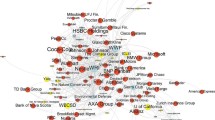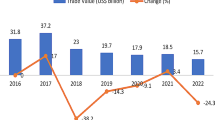Abstract
This paper studies a dynamic game between two national governments that fight a common terrorist organization that is seeking to mount a transnational terror campaign. It is the first examination that combines the temporal externalities associated with a sustained campaign with the spatial externalities that occur when the effects of one government’s counterterror policy spill over into another country. We consider two types of noncooperative behavior; one in which national authorities are sensitive to the reactions of the terrorists on foreign soil and another in which they are insensitive. It is shown that foreign terrorist sensitivity is preferred to insensitivity. Moreover, unilaterally accounting for terrorist reactions on foreign soil can be preferred to full policy coordination between governments. This then feeds into policy recommendations as to when each nation finds it desirable to coordinate transnational counterterror policy.
Similar content being viewed by others
Notes
No a priori assumptions are made, however, about the existence of first- or second-mover advantages.
In addition, an attack such as the Black September kidnaping of Israeli athletes at the 1972 Munich Olympic Games would qualify as a success even though few terrorists (and no athletes) survived. It certainly brought the cause of the Palestinians to prominence. By contrast, the successful extraction of hostages in a skyjacking [such as Lufthansa flight 181 during 1977 or Air France Flight 139 in 1976 (the Raid on Entebbe)] would not be deemed as a success because interventions such as these typically encourage other nations to develop similar highly trained rescue teams in order to credibly commit to a policy of no negotiation in future skyjackings.
In the games examined below, the terrorist organization makes its decisions after it observes governmental policy commitments. It is, therefore, able to calculate whether it is optimal to supply attacks in any given period.
Alternatively, one can assume that the government announces the counterterrorism effort rates, \(\left\{ {\varphi _t } \right\} _{t=0,\ldots ,\infty }\). Since \(g_t =\varphi _t a_t \) for \(\forall t\), this alternative game yields the same subgame-perfect Nash equilibrium as the one examined in the text. It is more convenient to treat the effort levels rather than the effort rates as the variables controlled by the government.
Our analysis focuses on the steady state because it is the usual way to carry out the comparative statics analysis for stable equilibria according to Samuelson’s correspondence principle. One can also analyze the path and speed of convergence to the steady- state equilibrium (see Footnote 11).
Dynamic optimization in discrete time methods can be found in macroeconomic textbooks such as Obstfeld and Rogoff [32, Chapter 2] as well as in environmental economics textbooks, e.g., Conrad [12, Chapter 1]. Euler equations are the basic first-order necessary conditions in the calculus of variations. It is worth noting that one of the most common methods to analyze convergence paths and speed to the steady state is through log-linearization method of the dynamic system formed by the Euler equations and dynamic constraints (e.g., Barro and Sala-i-Martin, [4, pp. 110-118]); however, the log- linearization applies only to the vicinity of the steady state.
The payoff function for the terrorist organization is
$$\begin{aligned}&\bar{{Y}}+\sum _{t=0}^\infty \rho ^{t}\left\{ a_{1,t} \left( {b+m\left( {a_{1,t-1} -g_{1,t-1} -\theta g_{2,t-1} } \right) } \right) \right. \nonumber \\&\left. \quad +\,a_{2,t} \left( b+m\left( {a_{2,t-1} -g_{2,t-1}-\theta g_{1,t-1} } \right) \right) -\frac{a_{1,t}^2 +a_{2,t}^2 }{2}-b\left( {1+\theta } \right) \left( {g_{1,t} +g_{2,t} } \right) \right\} , \end{aligned}$$where \(\bar{{Y}}={\bar{{y}}}/{\left( {1-\rho } \right) }\) if \(a_{j,t} >0\), \(j=1,2\), \(\forall t\). Since the terrorist organization takes \(g_{j,t} \) as given for \(j=1,2\) and \(\forall t\), the term \(b\left( {1+\theta } \right) \left( {g_{1,t} +g_{2,t} } \right) \) is constant and can be omitted from the relevant objective function. Note that the objective function is strict concave with respect to \(a_{j,t} ,j=1,2\). Hence, the first-order conditions are necessary and sufficient for a global maximum.
Recall that as the objective function is strictly convex and the constraints are given by affine functions, the first-order conditions are necessary and sufficient for a global minimum.
The equilibrium characterized by insensitivity in our context can be understood as a corner solution.
As each nation’s objective function is strictly convex and the constraints are given by affine functions, the first-order conditions are necessary and sufficient for a global minimum in each constrained minimization problem.
If, in addition, each sensitive nation were altruistic and were to care about the social costs incurred by the other nation just as much as they care about their own social costs, the problem solved by each sensitive nation would be mathematically identical to the problem solved by the international coalition.
It is important to note that the functions described by Eqs. (5c) and (5d) are derived from the terrorist organization’s best-response functions. They do not represent the nations’ best-response functions. They should be understood as “feedback functions.” The nations’ best-response functions are determined by taking the feedback functions into account.
This inequality is reached by multiplying \(a^{n}\) by \((1-\theta )/(1-\theta )\) and then canceling like terms.
References
Abrahms M (2011) Does terrorism work? Evolution of the conventional wisdom since 9/11. Def Peace Econ 22(6):583–594
Arce DG, Sandler T (2005) Counterterrorism: a game-theoretic analysis. J Confl Resolut 49:183–200
Arce D, Roberson B, Kovenock D (2012) Weakest-link attacker-defender games with multiple attack technologies. Nav Res Logist 59(6):457–469
Barro RJ, Sala-i-Martin X (2004) Economic growth, 2nd edn. MIT Press, Cambridge
Barros CP, Proença I, Faria JR, Gil-Alana L (2007) Are US citizens at risk of terrorism in Europe? Def Peace Econ 18:495–507
Becker GS, Murphy KM (1988) A theory of rational addiction. J Polit Econ 96:675–700
Behrens DA, Caulkins JP, Feichtinger G, Tragler G (2007) Incentive Stackelberg strategies for a dynamic game on terrorism. Ann Int Soc Dyn Games 9(Part V):459–486
Blomberg SB, Engel RC, Sawyer R (2009) On the duration and sustainability of transnational terrorist organizations. J Confl Resolut 54(2):303–330
Blomberg SB, Gaibulloev K, Sandler T (2011) Terrorist group survival: ideology, tactics and base of operations. Public Choice 149:441–463
Boyer M (1978) A habit forming optimal growth model. Int Econ Rev 19:585–609
Boyer M (1983) Rational demand and expenditure patterns under habit formation. J Econ Theory 31:27–53
Conrad JM (1999) Resource economics. Cambridge University Press, Cambridge
Cook D (2006) The role of Islam as a motivating factor in Usama bin Ladin’s appeal within the Muslim world. In: Kamien DG (ed) The McGraw-Hill homeland security handbook. McGraw-Hill, New York
Crettez B, Hayek N (2014) Terrorists’ eradication versus perpetual terror war. J Optim Theory Appl 160:679–702
Dahl EJ (2011) The plots that failed: intelligence lessons learned from unsuccessful attacks against the United States. Stud Confl Terror 24(8):621–648
Das S (2008) Some mechanisms of terror cycle. J Econ Behav Organ 67:644–656
Dockner EJ, Feichtinger G (1993) Cyclical consumption patterns and rational addiction. Am Econ Rev 83:256–263
Enders W, Sandler T (2000) Is transnational terrorism becoming more threatening? A time-series investigation. J Confl Resolut 44:307–332
Faria JR (2003) Terror cycles. Stud Nonlinear Dyn Econom 7(1). Article 3
Faria JR, Arce DG (2005) Terror support and recruitment. Def Peace Econ 16:263–273
Faria JR, Arce DG (2012a) Counterterrorism and its impact on terror support and recruitment: accounting for backlash. Def Peace Econ 23:431–445
Faria JR, Arce DG (2012b) A vintage model of terrorist organizations. J Confl Resolut 56(4):626–647
Feichtinger G, Novak AJ (2008) Terror and counterterror operations: differential game with cyclical Nash solution. J Optim Theory Appl 139:541–556
Gartenstein-Ross D (2011) Bin Laden’s legacy: why we’re still losing the war on terror. Wiley, Hoboken
Hashim AS (2006) Al-Qaida: origins, goals, and grand strategy. In: Kamien DG (ed) The McGraw-Hill homeland security handbook. McGraw-Hill, New York
Heal G, Kunreuther H (2005) IDS models of airline security. J Confl Resolut 49(2):201–217
Hoffman B (2006) Inside terrorism. Columbia University Press, New York
Horgan J (2005) The psychology of terrorism. Routledge, London
Iannaccone LR (1986) Addiction and satiation. Econ Lett 21:95–99
Kaplan E (2012) Estimating the duration of Jihadi terror plots in the United States. Stud Confl Terror 35:880–894
Novak AJ, Feichtinger G, Leitmann G (2010) A differential game related to terrorism: Nash and Stackelberg strategies. J Optim Theory Appl 144:533–555
Obstfeld M, Rogoff K (1996) Foundations of international macroeconomics. MIT Press, Cambridge
Rapoport DC (1992) Terrorism. In: Hawkesworth M, Kogan M (eds) Routledge encyclopedia of government and politics, vol 2. Routledge, London, pp 1067–70
Rosenbaum T (2008) The president has kept us safe. Wall Str J Opin 30:A15
Rozen K (2010) Foundations of intrinsic habit formation. Econometrica 78:1341–1373
Ryder HE, Heal GM (1973) Optimal growth with intertemporally dependent preferences. Rev Econ Stud 40:1–31
Sandler T, Arce D (2007) Terrorism: a game-theoretic approach. Handb Def Econ 2:775–813
Sandler T, Arce D, Enders W (2009) Transnational terrorism. In: Lomborg B (ed) Global crises, global solutions, 2nd edn. Cambridge University Press, Cambridge, pp 516–562
Sandler T, Arce D, Enders W (2011) An evaluation of Interpol’s cooperative-based counterterrorism linkages. J Law Econ 54(1):79–110
Sandler T, Siqueira K (2006) Global terrorism: deterrence versus preemption. Can J Econ 39:1370–1387
US Congress (2002) Joint inquiry into intelligence community activities before and after the terrorist attacks of September 11, 2001. Senate Report No. 107-351, House Report No. 107-792, Washington, DC
Woo G (2009) Intelligence constraints on terrorist network plots. In: Memon N et al (eds) Mathematical methods in counterterrorism. Springer, Wien, pp 205–214
Author information
Authors and Affiliations
Corresponding author
Rights and permissions
About this article
Cite this article
Faria, J.R., Silva, E.C.D. & Arce, D.G. Intertemporal Versus Spatial Externalities in Counterterror Policy Games. Dyn Games Appl 7, 402–421 (2017). https://doi.org/10.1007/s13235-016-0188-0
Published:
Issue Date:
DOI: https://doi.org/10.1007/s13235-016-0188-0
Keywords
- Spatial spillovers
- Intertemporal spillovers
- Counterterrorism
- Coordination failures
- History-dependent preferences




